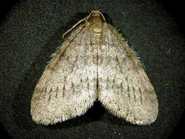 When moths fly with snow, let the Maine Forest Service know
If you are seeing moth flights this time of year, the Maine Department ofAgriculture, Conservation and Forestry’s Forest Service would like to know in order to better understand the locations and size of winter moth (Operophthera brumata) populations in Maine. Assistance from the public is being sought to help combat the destructive moth through use of a simple on-line survey to report winter moth sightings.
“The total economic impact of Maine’s forest industry is $8 billion with direct and indirect employment of 38,789 workers,” said Governor Paul R. LePage. “Fighting invasive insects like the winter moth is important to help protect that sector of our economy; in this case, hardwood trees and agricultural crops such as apples and blueberries. Public involvement will help professionals combat and minimize the destructive potential of this and other invasive species.”
Commissioner Walt Whitcomb stressed that filling out a simple online survey set by the Department to report winter moth sightings is very important. “These reports are critical to building the bigger picture of this insect’s distribution,” said Whitcomb. “A healthy forest is key to Maine’s forest economy. Citizen involvement in monitoring invasive pests is important to the future of rural Maine.”
The survey can be accessed online at: http://www.maine.gov/dacf/wintermothsurvey. Reports of moth flights can also be made by phone at (207) 287-2431.
Why Look For Moths in December?
December may seem like an odd time to set up traps for a defoliating forest pest. However, during the first week of December, DACF staff will set up traps along the coast and inland in southern Maine. Towns in the study region are cooperating by allowing traps to be hung on municipal property. Two homeowners in the most heavily infested areas have volunteered their services for a third year to make nightly counts of the moths trapped in their yards.
Winter in Maine is quite suitable to getting winter moth observations from the public. The moth flies when it is dark—this time of year many people are still out after dark. Even if people are inside and glance out their windows, they may notice if there are small tan moths attracted to lights.
Winter Moth History
The winter moth was introduced into North America from Europe in the early part of the last century. It was first seen in Nova Scotia in the 1930s and then in the Pacific Northwest (British Columbia, Oregon and Washington) in the 1970s. Winter moth showed up in eastern Massachusetts in the early 2000s and has since spread westward in MA, into Rhode Island and now coastal Maine from Kittery to Bar Harbor. It was first reported in Maine in significant numbers in December 2011.
The larvae (caterpillars) of winter moth defoliate deciduous trees and shrubs such as oaks, maples, apples and blueberries, in early spring. Heavy defoliation for several consecutive years leads to branch dieback and tree mortality. Winter moth defoliation has contributed to tens of thousands of acres of oak mortality in Massachusetts.
Winter moth defoliation was first recorded in Maine in 2012. This year the annual Maine Forest Service aerial survey picked up moderate to heavy defoliation in the Cumberland County towns of Cape Elizabeth, Chebeague Island, Harpswell, Portland (Peaks Island) and Scarborough with over 10,000 acres mapped. On the ground, light to heavy defoliation could be seen in scattered locations from Kittery to Rockland.
Adults are active from late November to January whenever the temperature is above freezing. Males are small, light brown to tan moths. They are attracted to lights and a chemical released by the females. Adult females are small, gray and look like a mosquito wearing a fur coat. They have reduced wings and are flightless. Females are most commonly found crawling on the trunks of trees.
So if you see moths flying in December, let the Maine Forest Service know.
|